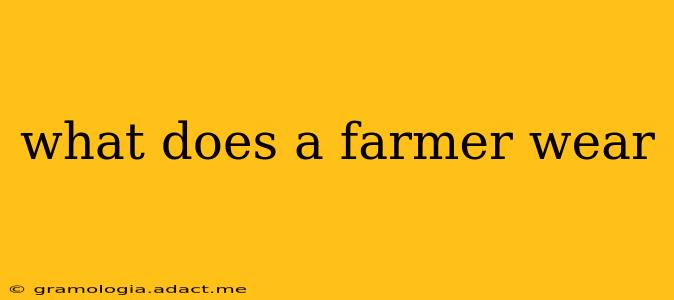What Does a Farmer Wear? A Comprehensive Guide to Farm Attire
Farmers' clothing isn't just about fashion; it's about safety, practicality, and comfort during long hours of hard work in diverse conditions. What a farmer wears depends heavily on the season, the specific tasks at hand, and the type of farming they're doing. Let's delve into the details.
What kind of clothes do farmers wear in the summer?
Summer farm work demands clothing that's lightweight, breathable, and protective from the sun and insects. Common choices include:
- Lightweight, long-sleeved shirts: These offer protection from sunburn and irritating plants like poison ivy. Many farmers opt for moisture-wicking fabrics to stay cool and dry.
- Loose-fitting pants: Jeans are popular, but lighter-weight canvas or cotton pants are also common choices. Again, breathability is key.
- Durable work boots: Steel-toed boots are often preferred for safety, but sturdy leather boots offer excellent protection as well. Good ankle support is vital to prevent sprains.
- Sun hat: A wide-brimmed hat is essential to shield the face and neck from the sun's harmful rays.
- Insect repellent: Mosquitoes, ticks, and other biting insects are a major concern in summer.
- Sunglasses: Protecting your eyes from the sun is as important as protecting your skin.
What kind of clothes do farmers wear in the winter?
Winter farm work requires clothing that provides warmth, insulation, and protection from the elements. Farmers often layer their clothing to maintain optimal body temperature. This might include:
- Thermal underwear: A base layer of thermal underwear helps trap body heat and wick away moisture.
- Insulated jackets and pants: Durable, insulated outerwear is essential for protection against cold winds and precipitation.
- Waterproof outer layers: A waterproof jacket and pants are vital for staying dry during rain or snow.
- Warm socks and boots: Insulated boots and thick, wool socks are crucial for keeping feet warm and dry.
- Gloves or mittens: Warm, waterproof gloves or mittens are necessary for protecting hands from cold and moisture.
- Hats and scarves: Keeping your head and neck warm helps to retain body heat.
What type of clothing protects farmers from hazards?
Farm work presents numerous hazards, and appropriate clothing plays a crucial role in minimizing risk. This includes:
- High-visibility clothing: Brightly colored or reflective clothing improves visibility, particularly when operating machinery or working near roadways.
- Safety glasses or goggles: Protecting eyes from dust, debris, and chemicals is paramount.
- Hearing protection: Noise from machinery can cause hearing damage; earplugs or earmuffs are essential.
- Gloves: Specialized gloves provide protection from various hazards, such as cuts, chemicals, and extreme temperatures. Different tasks demand different types of gloves.
- Steel-toed boots: These protect feet from crushing injuries.
What materials are best for farm clothing?
Durability and practicality are paramount when choosing materials for farm clothing. Common choices include:
- Cotton: A breathable and comfortable natural fiber, ideal for warm weather.
- Canvas: A durable and sturdy material, suitable for work pants and jackets.
- Denim: Tough and long-lasting, jeans are a staple for many farmers.
- Polyester: A synthetic fiber that's moisture-wicking and quick-drying.
- Nylon: A durable and water-resistant synthetic fiber.
What are some common brands of farm clothing?
Many workwear brands cater to the needs of farmers, often providing durable, functional clothing designed for comfort and safety. Examples include Carhartt, Wrangler, and Dickies, but numerous smaller, specialized brands also exist. The best brand will depend on individual preferences and needs.
Ultimately, the clothing a farmer wears is a reflection of their work environment and the demands of their job. It's a blend of practicality, safety, and comfort tailored to the specific challenges of agricultural life.
